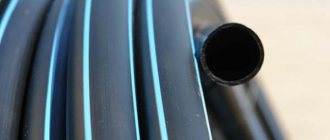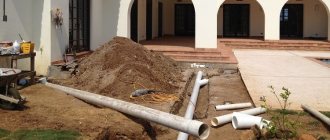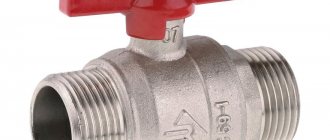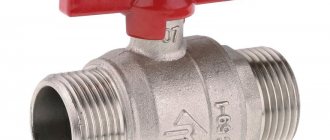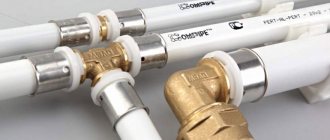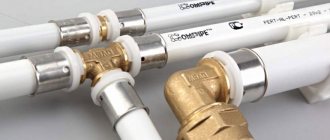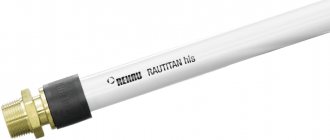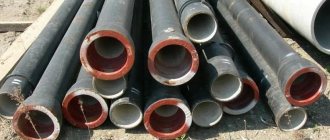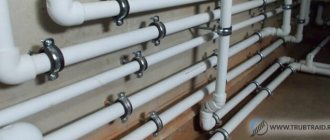Until recently, the choice of casing pipes used for well construction was limited to products made from asbestos cement and metal. Currently, uPVC casing pipes are increasingly being used, which, when compared with metal and asbestos-cement pipes, has many advantages.
UPVC casing pipe with trapezoidal thread
What is
A uPVC casing pipe is a hollow cylinder, usually 2 to 6 meters long. It is made of plastic – unplasticized PVC. It is inserted into a drilled well to protect its walls from destruction and ensure normal operation of the pump and other components of the drilling rig.
Available in blue color, it has a range of sections from 80 to 400 mm, with wall thicknesses up to 21.5 mm.
Advantages and disadvantages of uPVC pipes
These pipes have many advantages, here are the main ones:
- They are made in accordance with sanitary standards;
- They do not deteriorate from exposure to chemical elements;
- They serve for quite a long time;
- They are completely sealed;
- They are easy to install;
- They are light in weight, so they are easy to transport;
- Do not burst from excessive load;
- Made from materials that do not emit harmful substances;
- Pipes are not subject to overgrowth and do not wear out;
- With all this they have a small price.
These advantages make it clear that the choice is obvious. Whatever the arrangement of things, uPVC pipes become the best choice. They are ideal in comparison with previously invented options.
Naturally, they have some disadvantages. But they are very few and easy to avoid. This is more due to the fact that they can be damaged if you put a lot of force on them from the side. They can crack if there are additional moving layers in the ground.
Performance characteristics
The pipes are sufficiently durable and have a favorable price. In addition, they are convenient to assemble: they are lightweight, and the installation technology is simple and accessible to non-specialists. The threaded connections are so strong that they allow the polymer pipeline to be pulled out of the drilling rig if necessary.
- Bends are produced with and without socket.
- The range of working sections used for casing varies from 80 to 225 mm.
- The maximum internal pressure for uPVC bends is 25 MPa.
- They can be installed at a depth of up to 100 meters, and reinforced versions (with thick walls) - up to 300 meters.
The products have a smooth surface, providing high throughput capacity, resistance to overgrowth and bacterial growth.
Differences from PVC pipes
The difference is that uPVC does not contain plasticizers, which are used in polyvinyl chloride to give the material plasticity.
Unplasticized polyvinyl chloride is harder and stronger than regular PVC. Experts recognize this modification as the most durable among all types of polymer materials.
ORDER PROFESSIONAL WELL DRILLING
The installation of a water well by our company’s specialists is carried out as quickly as possible, regardless of the complexity of the task. During the installation of an autonomous water supply system, we use only the most modern technology and appropriate equipment, as well as high-quality materials from leading manufacturers.
The materials we use have all the necessary quality certificates and fully comply with GOST and sanitary standards. The uPVC pipes that we use for casing wells are manufactured domestically, which is a pioneer in this industry. It has been supplying materials for drilling that fully comply with all international norms and standards for more than 20 years.
Areas of application
The products are widely used where qualities such as strength and rigidity of plastic bends are in demand:
- Laying pressure and non-pressure sewerage pipelines.
- Transportation of drinking water and other food liquids.
- Construction of drainage networks.
- Construction of casing columns on water wells.
- Manufacturing of protective equipment for athletes and other areas of human activity.
For well
In well drilling, one of the main problems is ensuring the integrity of the drilling rig and protecting equipment from various external mechanical loads. These problems are successfully solved with the help of casing pipes. Previously, steel and asbestos-cement bends were used for these purposes. Now they are being forced out of the market by cheaper and easier to install plastic pipelines. The most profitable and effective among them are pipes made of unplasticized PVC.
WELL DRILLING FROM AN EXPERIENCED COMPANY
If you need the best drilling company in Moscow and the Moscow region, which quickly and efficiently drills a well for limestone in the Moscow region, contact us at PRO100BURENIE ! Our main specialization is drilling and installation of water wells. We also additionally provide service and repair of downhole equipment. We guarantee that experienced and highly qualified specialists will easily perform the following types of work:
- drilling wells for limestone in the Moscow region and Moscow;
- installation of water supply from a well;
- arrangement of a well with a caisson;
- installing a pump in a well;
- repair and maintenance of well equipment of any complexity.
If you need an inexpensive but high-quality turnkey artesian well, the price in the Moscow region for drilling and equipment from our company is the lowest in the entire region. In a special section of the site with a price list for the services we provide, you can find out how much it costs to drill an artesian well in the Moscow region. If you are interested in a more specific price, you can call us at our contact number to get a free consultation and find out how much it costs to drill a water well, taking into account all the individual characteristics of your area.
Advantages and disadvantages of casing pipes made of unplasticized polyvinyl chloride
Let's look at their pros and cons. The advantages are:
- Greater strength and rigidity, the ability to withstand external loads, which is especially important for casing pipes.
- No signs of corrosion.
- Resistance to chemicals, including toxic ones.
- Light weight, simple installation technology.
- The service life of uPVC pipes declared by manufacturers is 50 years.
- More optimal price-quality ratio compared to its competitors.
Where uPVC pipes are inferior is their resistance to lateral loads from soil and groundwater movement.
The frost resistance of this type of bend also leaves much to be desired. At 50-degree frost they can burst. Therefore, insulation of the upper parts of the casing is one of the necessary procedures.
Types of pipes
In order to supply water to the site, it is necessary to drill a well. But this is just the beginning. To get water to the right place, you need to insert a pump. But in order to place it there, you must first place the pipe in the drilled hole.
Pipes are made of metal, asbestos cement or uPVC. The first two options are quite difficult. To load them, you need to use a special forklift. This causes a lot of inconvenience. Metal products, in addition to everything, have a high price. Therefore, not everyone can buy them.
But asbestos-cement pipes are much cheaper. But they are inconvenient to install in the hole. If there is a large load on them, they may burst. This causes the hole to become blurry and can then become much more dirty. Therefore, it is not advisable to use it in the future. The only option is to drill a new hole. This means that you will again have to spend a large amount of money.
UPVC pipes are different in that they do not have these disadvantages. They are very easy to install in a well. Their price is very affordable. Plus, in addition to all of the above, they are light in weight, so it is not necessary for them to take additional auxiliary forces for lifting.
Varieties and assortment
PVC-U bends for wells are divided according to the type of connection. They can be:
- Bell-shaped (with thread, with an elastic ring seal).
- With adhesive connection under the socket.
- Without a socket with cut threads on the ends of the pipes.
Dimensions and diameters
Bends for wells are produced in sections from 4 to 12 meters in length, with a cross-section from 90 mm to 225 mm. The most common standard size is considered to be a diameter of 125 mm with a wall thickness of up to 7.4 mm.
For wells with a depth of up to 300 meters, pipes with reinforced walls up to 23.2 mm are used.
Marking features
Every meter, markings are applied to the surface of the product. It represents mandatory information, the content of which is determined by the requirements of GOST.
What do the symbols on the label mean?
Let's look at a specific example of decoding the inscription
PVC-U pipe - P - 125×7.4 x3000 GOST R 51613-2000 06.2018:
- UPVC or PUC-U is a Russian or international designation of the material.
- P – presence of a bell.
- 125×7.4×3000 – section, wall size, length of the segment.
- Designation of the standard according to which the product was manufactured.
- Date of issue.
Tips for choosing products
Before purchasing a PVC-U column, calculate the maximum water flow when all water appliances are turned on at the same time. Determine the required pump power and its dimensions. Based on this, the diameter of the future casing is selected.
In wells (the depth to the water table is more than 9-10 meters), submersible pumps are used, the smallest diameter of which is 76 mm. The casing should be wider (in this case 100 mm).
approximate cost
The price of the product depends on the cross-section, wall thickness, length of the outlet, and the volume of purchased products. They install it either per meter or per piece.
A casing pipe with a cross-section of 125 mm and a wall of 5 mm from a Russian manufacturer can be purchased for 372 rubles/linear. m. A casing with the same diameter, but a wall thickness of 7.5 mm will cost 553 rubles per meter.
Which casing pipe is better to use for a well when drilling
If the depth of the aquifer is higher than 8 meters, then a branch with a diameter of 60 mm is suitable for casing.
From a depth of 9 meters, only submersible pumps are used, and their cross-section starts from 76 mm. In addition, a reserve is needed so that the equipment can be easily pulled out. Therefore, deeper levels will require pipes with a diameter of 90 millimeters or more.
The deeper the well is drilled, the greater the load on the pipeline becomes, the thicker the walls of the bends should be. So 4 mm is recommended for wells up to 30 m, 5 mm - up to 65 m, 6 mm - up to 115 meters.
How to drill
When using uPVC casing pipes, it is important that the well is smooth, straight, without bends or slopes.
- First, they dig a pit - a depression 1.5-2 meters deep and 1.5 by 1.5 meters wide. It reduces the drilling depth and prevents the soil from collapsing around the well.
- The first five meters (the perched layer) are passed with a wide drill, for example, with a cross-section of 140 mm.
- In the second section, a smaller drill (130 mm) is used.
- An even smaller drill (125 mm) is installed in front of the aquifer.
- The moment when drilling needs to be stopped is determined by continuous analysis of the soil removed by the drilling equipment.
- The casing pipe is lowered into the finished well.
The construction of the well is completed by flushing it until the pump begins to supply clean water.
How to properly strengthen the walls of a pit
In order for the pit to fulfill its task of protecting the canal from soil collapse, its walls are strengthened. Construct wooden formwork from boards or plywood.
After completion of drilling and installation of the casing, the walls are covered with bricks - a ready-made caisson is obtained in which equipment for the well and pump can be installed.
There are ready-made solutions: plastic or steel caissons. In practice, they often resort to the construction of a ring well-caisson from reinforced concrete rings. Their dimensions are as follows: cross-section 1.5 m, depth – 2 m, i.e. below freezing point.
The caissons are insulated and covered with an insulated lid. In this case, the well will not freeze, and there will be no need to lay a heating cable.
Benefit for the customer
Now let's see why a potential customer needs all this.
Currently, the price on the market for a meter of drilling a well starts from 1,800 rubles. This is a single-pipe design, most often the pipe diameter is 133 mm, with threaded connections. The design was “invented” after many years of struggle for economy, in violation of all drilling canons, and is used everywhere. Pipe-to-pipe threading to reduce the drilling diameter, the use of 3ps steel (the lowest-grade and softest), the transition to electric-welded seam pipes instead of seamless ones, reducing the wall thickness down to 4 mm... A lot of things were “introduced” by various kinds of specialists in conditions of complete lack of control. Such a design can even last 10 years, there have been cases, but most often much less. Why? thin wall, along the entire length of the pipe there is a weld as a source of corrosion, at the threaded ends the thickness of the metal reaches the thickness of paper, there is no tightness of the threads... We also shamelessly include here all sorts of “reinforced ends”, “metal-plastic” pipes, etc., which are a common marketing ploy at the “cholesterol-free vegetable oil” level and do not bring any practical benefit.
What about uPVC? The pipe is available with different wall thicknesses and a manufacturer’s guarantee for withstanding external pressure. The threads are the same for all wall thicknesses on each diameter and are equipped with a rubber O-ring. Thus, you can always select a reliable column for any well depth. Any company that has mastered the correct and safe technology for constructing a well will give you a sealed structure that can last for decades (no one doubts the durability of PVC). Talk about the “non-repairability” of wells on such a pipe compared to a steel column is from the evil one. Find at least one real person who had a well drilled using the cheapest option repaired!
The warranty on a “Steel 133” well is unlikely to exceed three years, but a well-made uPVC well can be safely given a “lifetime” guarantee.
Features of installation and connection
Well casing is carried out either after completion of drilling or during the process. Based on what kind of soil you will have to deal with. If the channel is deep and on loose soil, then a pipe is installed and drilling is carried out inside the column with a drill of a smaller diameter. This process is more troublesome, so they often try to drill the well to the end and then begin installing the casing.
It is important to position the first casing correctly. It is checked for level and securely fixed. As it goes down, the pipe is extended with the next bend.
A filter is also installed on the initial pipe. In the column it will be located at the very bottom, ensuring the flow of filtered water into the well. It is made by drilling holes in the lower part of the outlet and wrapping the area with a filter mesh secured with self-tapping screws.
The gap between the walls of the well and the column is filled with fine crushed stone and filled with concrete through a hose. It will prevent melt water from flowing down to the base of the column.
Connection methods
Connections are made in the following ways:
- Through a socket with an o-ring. The pipe is inserted into the socket until it stops; the seal must not jump out of the special recess.
- Glue method. The inner surface of the socket and the end of the inserted outlet are coated with an adhesive solution.
- Threaded method. The end of the upper pipe is screwed onto the pipe below.
